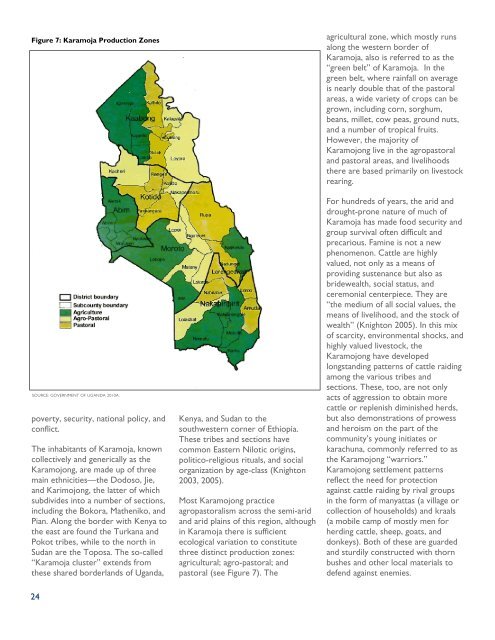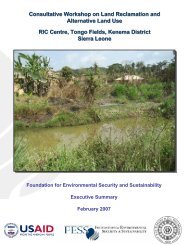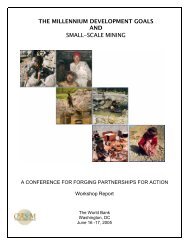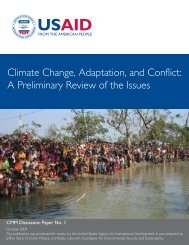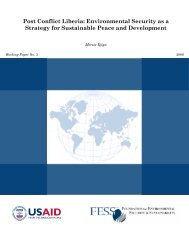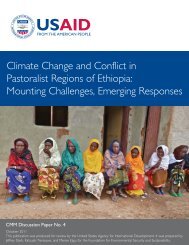Climate Change and Conflict in Uganda: The Cattle Corridor - FESS ...
Climate Change and Conflict in Uganda: The Cattle Corridor - FESS ...
Climate Change and Conflict in Uganda: The Cattle Corridor - FESS ...
Create successful ePaper yourself
Turn your PDF publications into a flip-book with our unique Google optimized e-Paper software.
Figure 7: Karamoja Production Zones<br />
SOURCE: GOVERNMENT OF UGANDA 2010A.<br />
poverty, security, national policy, <strong>and</strong><br />
conflict.<br />
<strong>The</strong> <strong>in</strong>habitants of Karamoja, known<br />
collectively <strong>and</strong> generically as the<br />
Karamojong, are made up of three<br />
ma<strong>in</strong> ethnicities—the Dodoso, Jie,<br />
<strong>and</strong> Karimojong, the latter of which<br />
subdivides <strong>in</strong>to a number of sections,<br />
<strong>in</strong>clud<strong>in</strong>g the Bokora, Matheniko, <strong>and</strong><br />
Pian. Along the border with Kenya to<br />
the east are found the Turkana <strong>and</strong><br />
Pokot tribes, while to the north <strong>in</strong><br />
Sudan are the Toposa. <strong>The</strong> so-called<br />
“Karamoja cluster” extends from<br />
these shared borderl<strong>and</strong>s of Ug<strong>and</strong>a,<br />
Kenya, <strong>and</strong> Sudan to the<br />
southwestern corner of Ethiopia.<br />
<strong>The</strong>se tribes <strong>and</strong> sections have<br />
common Eastern Nilotic orig<strong>in</strong>s,<br />
politico-religious rituals, <strong>and</strong> social<br />
organization by age-class (Knighton<br />
2003, 2005).<br />
Most Karamojong practice<br />
agropastoralism across the semi-arid<br />
<strong>and</strong> arid pla<strong>in</strong>s of this region, although<br />
<strong>in</strong> Karamoja there is sufficient<br />
ecological variation to constitute<br />
three dist<strong>in</strong>ct production zones:<br />
agricultural; agro-pastoral; <strong>and</strong><br />
pastoral (see Figure 7). <strong>The</strong><br />
agricultural zone, which mostly runs<br />
along the western border of<br />
Karamoja, also is referred to as the<br />
“green belt” of Karamoja. In the<br />
green belt, where ra<strong>in</strong>fall on average<br />
is nearly double that of the pastoral<br />
areas, a wide variety of crops can be<br />
grown, <strong>in</strong>clud<strong>in</strong>g corn, sorghum,<br />
beans, millet, cow peas, ground nuts,<br />
<strong>and</strong> a number of tropical fruits.<br />
However, the majority of<br />
Karamojong live <strong>in</strong> the agropastoral<br />
<strong>and</strong> pastoral areas, <strong>and</strong> livelihoods<br />
there are based primarily on livestock<br />
rear<strong>in</strong>g.<br />
For hundreds of years, the arid <strong>and</strong><br />
drought-prone nature of much of<br />
Karamoja has made food security <strong>and</strong><br />
group survival often difficult <strong>and</strong><br />
precarious. Fam<strong>in</strong>e is not a new<br />
phenomenon. <strong>Cattle</strong> are highly<br />
valued, not only as a means of<br />
provid<strong>in</strong>g sustenance but also as<br />
bridewealth, social status, <strong>and</strong><br />
ceremonial centerpiece. <strong>The</strong>y are<br />
“the medium of all social values, the<br />
means of livelihood, <strong>and</strong> the stock of<br />
wealth” (Knighton 2005). In this mix<br />
of scarcity, environmental shocks, <strong>and</strong><br />
highly valued livestock, the<br />
Karamojong have developed<br />
longst<strong>and</strong><strong>in</strong>g patterns of cattle raid<strong>in</strong>g<br />
among the various tribes <strong>and</strong><br />
sections. <strong>The</strong>se, too, are not only<br />
acts of aggression to obta<strong>in</strong> more<br />
cattle or replenish dim<strong>in</strong>ished herds,<br />
but also demonstrations of prowess<br />
<strong>and</strong> heroism on the part of the<br />
community’s young <strong>in</strong>itiates or<br />
karachuna, commonly referred to as<br />
the Karamojong “warriors.”<br />
Karamojong settlement patterns<br />
reflect the need for protection<br />
aga<strong>in</strong>st cattle raid<strong>in</strong>g by rival groups<br />
<strong>in</strong> the form of manyattas (a village or<br />
collection of households) <strong>and</strong> kraals<br />
(a mobile camp of mostly men for<br />
herd<strong>in</strong>g cattle, sheep, goats, <strong>and</strong><br />
donkeys). Both of these are guarded<br />
<strong>and</strong> sturdily constructed with thorn<br />
bushes <strong>and</strong> other local materials to<br />
defend aga<strong>in</strong>st enemies.<br />
24


